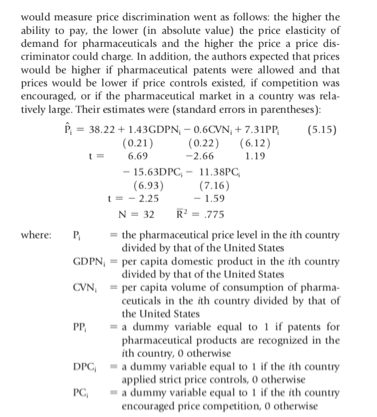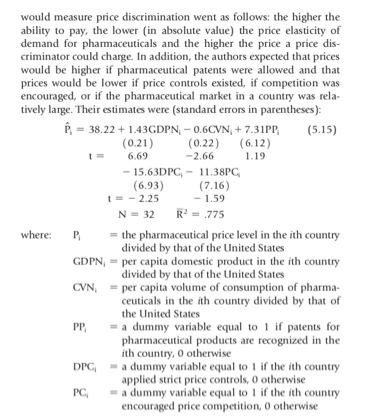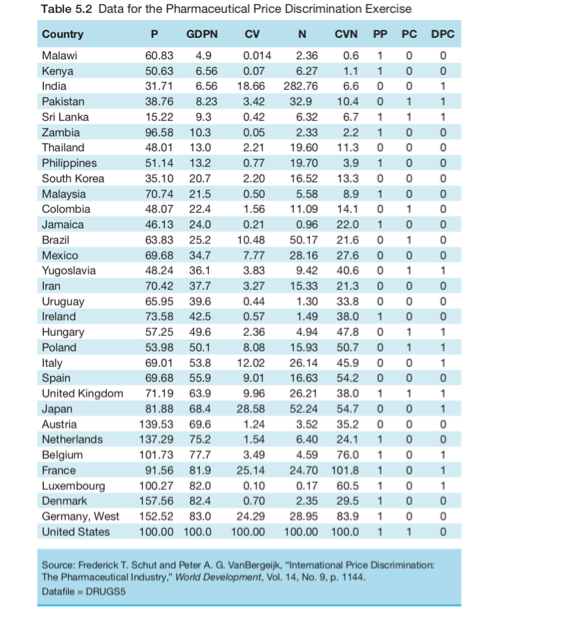pleaae solve the problem using STATA ,and the date is provided. thank you
Frederick Schul and Peter Van Bergrijk" published an article in which they attempted to SEE if the pharmaceutical industry practiced inter - national price discrimination by calimating a model of the prices of pharmaceutical in a cross section of } } countries . The author Fell that if price discrimination Existed, then the cactficient of per capita! income in a properly specified price equation would he strongly Fugitive . The reason they felt that the cartficient of per capita incomewould measure price discrimination went as follows: the higher the ability to pay, the lower (in absolute value) the price elasticity of demand for pharmaceuticals and the higher the price a price dis- criminator could charge. In addition, the authors expected that prices would be higher if pharmaceutical patents were allowed and that prices would be lower if price controls existed, if competition was encouraged, or if the pharmaceutical market in a country was rela- tively large. Their estimates were (standard errors in parentheses): P = 38.22 + 1.43GDPN; - 0.6CVN; + 7.31PP. (0.21) (5.15) (0.22) (6.12) 6.69 -2.66 1.19 - 15.63DPC, - 11.38PC (6.93) (7.16) 1 = - 2.25 - 1.59 N = 32 RI = .775 where: P = the pharmaceutical price level in the ith country divided by that of the United States GDPN, = per capita domestic product in the ith country divided by that of the United States CVN, = per capita volume of consumption of pharma- ceuticals in the ith country divided by that of the United States PP = a dummy variable equal to 1 if patents for pharmaceutical products are recognized in the ith country, 0 otherwise DPC - a dummy variable equal to 1 if the ith country PC applied strict price controls, 0 otherwise " a dummy variable equal to 1 if the ith country encouraged price competition, 0 otherwisewould measure price discrimination went as follows: the higher the ability to pay, the lower (in absolute value) the price elasticity of demand for pharmaceuticals and the higher the price a price dis- criminator could charge. In addition, the authors expected that prices would be higher if pharmaceutical patents were allowed and that prices would be lower if price controls existed, if competition was encouraged, or if the pharmaceutical market in a country was rela- tively large. Their estimates were (standard errors in parentheses): P = 38.22 + 1.43GDPN; - 0.6CVN; + 7.31PP. (0.21) (5.15) (0.22) (6.12) 6.69 -2.66 1.19 - 15.63DPC, - 11.38PC (6.93) (7.16) 1 = - 2.25 - 1.59 N = 32 RI = .775 where: P = the pharmaceutical price level in the ith country divided by that of the United States GDPN, = per capita domestic product in the ith country divided by that of the United States CVN, = per capita volume of consumption of pharma- ceuticals in the ith country divided by that of the United States PP = a dummy variable equal to 1 if patents for pharmaceutical products are recognized in the ith country, 0 otherwise DPC - a dummy variable equal to 1 if the ith country PC applied strict price controls, 0 otherwise " a dummy variable equal to 1 if the ith country encouraged price competition, 0 otherwiseTable 5. 2 Data for the Pharmaceutical Price Discrimination Exercise Country GOPN CV CVN PP FC OFC Malawi` 0.01 4 2.36 O. E Kenya 50. 63 6. 56 0. 07 5 . 27 1 . 1 India 31. 71 6. 56 1 8. 60 ZEZ. TO B. B Pakistan 38. 76 $. 23 3.42 32.9 10.4 Sri Lanka 15.22 9.3 0. 42 6.32 6 . 7 1 1 Zambia $6.58 10.3 0. 05 2.39 2.2 Thailand 48.0 13.0 2.21 19.60 1 1.3 Philippines 51. 14 12.2 19.70 3.9 South Korea 35.10 20.7 2.20 16.52 13.3 Malaysia 70. 74 21.5 0. 50 5.58 Colombia 48. 07 22. 4 1. 50 1 1.09 14. 1 Jamaica 46.13 24.0 22.0 1 950 0 .21 - 0 0 0 - 0 0 0 0 0 0 0 0 0 Brazil 6.3. 8.3 25. 2 10. 48 50. 17 21 . 6 Mexico 69. 68 34.7 T. IT 28. 16 27 . 6 Yugoslavia $8. 24\\ 36.1 3. 83 9. 42 Iran 70. 42 37 . 7 3.27 15. 23 21. 3 Uruguay 6:5. 95 39.6 0. 4 4 1. 30 32. 8 Ireland 73.58 42.5 0.57 1. 49 3.8. 0 Hungary 57. 25 49.6 2.36 4.94 AT. B Poland 53.98\\ 50. 1 15.93 50.7 Italy 6.9. 01 53.8 12.02 26. 14 45.9 Spain 69. 6.8 5.5.9 9.01 16. 6.3 5.4.2 United Kingdom 71. 19 63.9 26.21 3.8.0 Japan $1. 8.8\\ 68 . 4 28.58. 52.24 5:4.7 Austria 139.53 69. 6 1. 24 3.52 35.2 Netherlands 137.29\\ 75.2 1. 54 6. 40 24.1 Belgium 101. 73\\ ` TT. T 3. 49 4.59 76. O I France 91. 56\\ 81.9 25. 14 24.70 101 . 8 Luxembourg 100. 27\\ 82.0 0. 10 0. 17 60. 5 Denmark 157. 56 8.2. 4 0. 70 2.35 29.5 Germany , West 152.52\\ 83.0 24.29 28.95 $.3. 9 O 1 0 United States 100.00 100. 0 100.00 100.00 100. 0 Source : Frodonick T. Schut and Palm AG. VanBorgolyk, "Intomational Price Discrimination The Pharmaceutical Industry, " Hand Downlamont , VOL. 14. No. 9. 1. 19^` Batalla & DRUGS5










